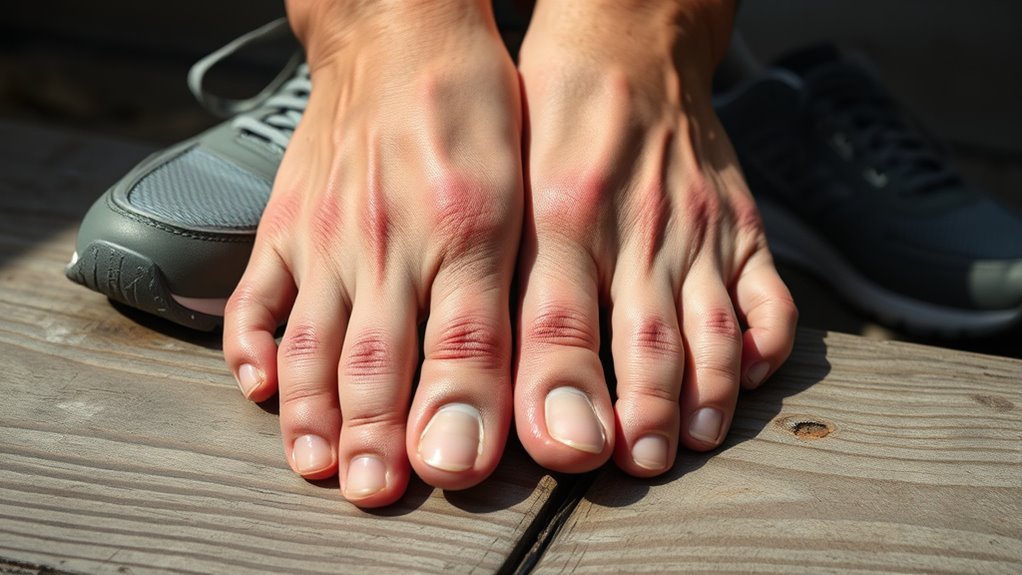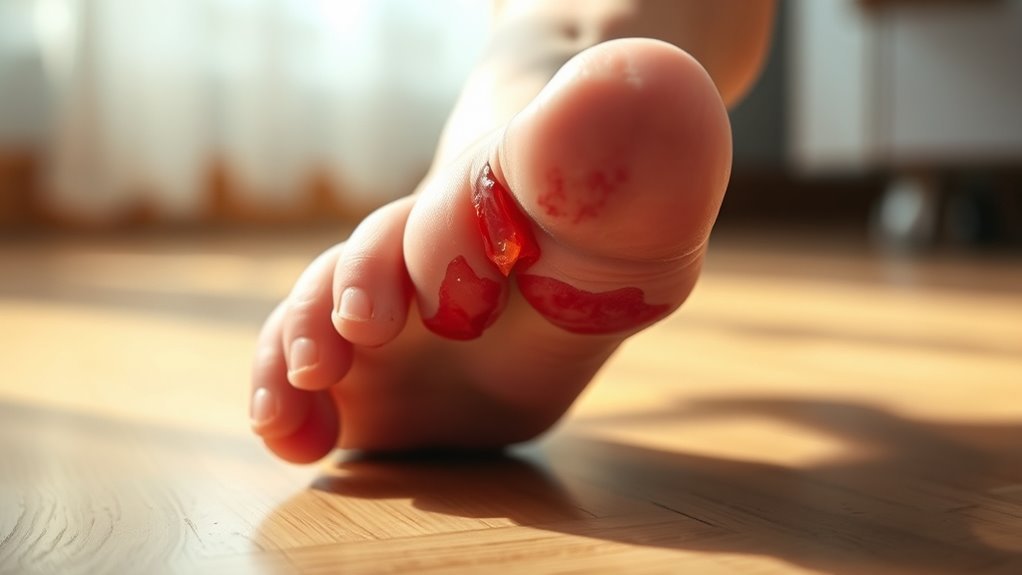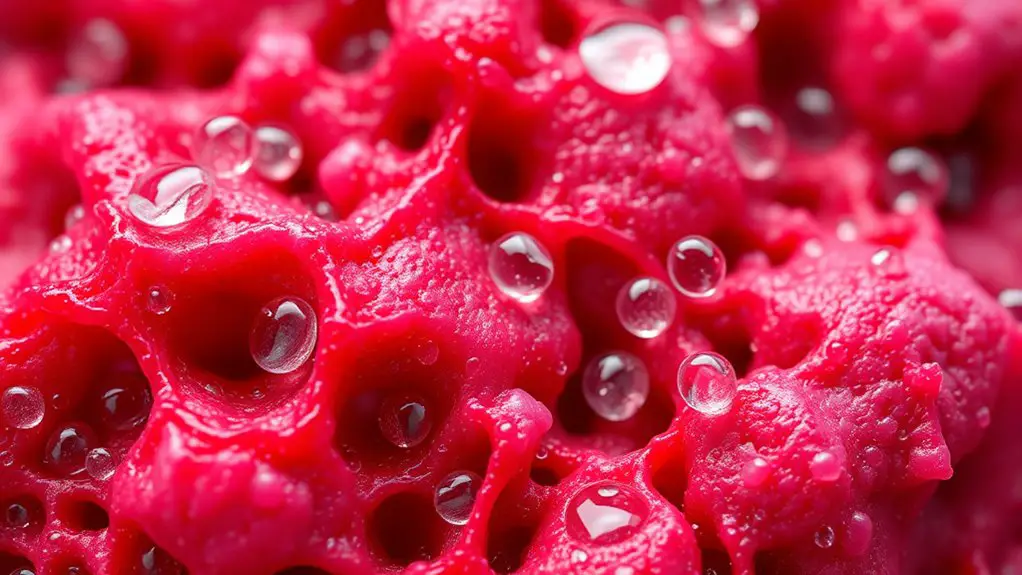Yes, you can get athlete’s foot on your hands. This fungal infection thrives in damp environments and can spread through direct contact with infected areas. Symptoms like redness, itching, and peeling skin can occur. Risk factors include poor hygiene and sweating. If you notice symptoms, it’s important to seek treatment to prevent further complications. Understanding how to prevent and manage this condition can help you stay comfortable and healthy. There’s more to learn about protecting yourself from this infection.
Understanding Athlete’s Foot: The Basics
Athlete’s foot is often thought of as a pesky issue that only affects your feet, but it can actually manifest on your hands, too. This skin condition, caused by fungi, thrives in warm, moist environments, making your hands just as vulnerable as your feet. You might notice redness, itching, or peeling skin if you’ve got it on your hands. It’s vital to recognize this early, as ignoring it can lead to more discomfort and potential spreading. The freedom of using your hands without worry is important, so being aware of athlete’s foot symptoms can empower you to take action. With proper hygiene and treatment, you can keep your hands healthy and free from this annoying skin condition, letting you embrace life fully.
How Fungal Infections Spread
Fungal infections can spread in a variety of ways, often catching you off guard when you least expect it. One common method is through direct skin contact. If you touch an infected area, those pesky fungal spores can transfer to your hands and lead to problems. It’s easy to overlook this when you’re just living your life, but being mindful of where you place your hands can make a difference. Shared spaces, like gym locker rooms or communal showers, are hotspots for these infections. Even if you feel invincible, remember that taking simple precautions—like wearing flip-flops—can help you avoid unwanted fungal guests. So, keep your hands clean and be aware of your surroundings to maintain your freedom from these bothersome infections.
Symptoms of Athlete’s Foot on Hands
When you notice unusual changes on your hands, it could signal a case of athlete’s foot affecting that area. The symptoms often include redness, itching, and hand irritation that can feel uncomfortable and even frustrating. You might also spot dry or flaky skin, which can lead to cracking if left untreated. Swelling could accompany these symptoms, further complicating your daily activities. Pay attention to these signs for accurate symptom identification, as recognizing them early can help you take action sooner. If you experience any of these issues, it’s essential to consult a healthcare professional for guidance. Embracing freedom means caring for your health, so don’t hesitate to address any concerns regarding athlete’s foot on your hands.
Risk Factors for Developing Athlete’s Foot on Hands
Several factors can increase your chances of developing athlete’s foot on your hands. First, poor hand hygiene is a significant risk; without regular washing, you’re exposing your skin to fungi. If you’re frequently in damp environments, like pools or locker rooms, your hands may be at higher risk too. Additionally, any damage to your skin barriers, such as cuts or eczema, can make it easier for fungi to invade. Sweaty hands can also contribute, as moisture creates an ideal breeding ground. Finally, if you’ve had athlete’s foot on your feet, the fungus can easily spread to your hands. By maintaining good hand hygiene and protecting your skin barriers, you can reduce the risks and keep your freedom intact.
Common Causes of Athlete’s Foot on Hands
Athlete’s foot can spread to your hands through fungal infections, especially if you come into contact with contaminated surfaces. Poor hygiene practices, like not washing your hands regularly, can also increase your risk. Understanding these common causes can help you take steps to prevent the condition.
Fungal Infection Transmission
Although many people associate athlete’s foot with the feet, it can also spread to your hands through various means. Fungal transmission occurs mainly via direct contact with infected surfaces or skin. You might pick up the fungus from shared towels, shoes, or locker room floors. Maintaining good hand hygiene is essential for preventing this unwelcome transfer.
Here’s a quick overview of common ways athlete’s foot can transmit to your hands:
| Source | Risk Level | Prevention |
|---|---|---|
| Shared towels | High | Use personal towels |
| Infected surfaces | Medium | Disinfect regularly |
| Direct skin contact | High | Avoid touching infected skin |
Stay vigilant, and you’ll keep your hands fungus-free!
Poor Hygiene Practices
Poor hygiene practices can greatly increase the risk of athlete’s foot spreading to your hands. If you neglect proper hand washing, especially after touching contaminated surfaces or your feet, you’re inviting trouble. Fungal spores thrive in damp, warm environments, so failing to dry your hands thoroughly can lead to infection.
Additionally, sharing personal items like towels or shoes can spread the fungus. Remember, your hands often touch your face, so if they’re contaminated, you might inadvertently transfer those spores. Keeping your hands clean and dry is essential for maintaining freedom from this pesky condition. Prioritize good hygiene habits and regular hand washing to safeguard yourself against athlete’s foot on your hands. Stay vigilant, and don’t let poor hygiene compromise your well-being!
Diagnosis: How to Identify the Infection
How can you tell if you have Athlete’s Foot on your hands? First, look for visual signs like redness, itching, and peeling skin. You might notice cracks, blisters, or a flaky texture that feels uncomfortable. These symptoms can be your body’s way of saying something’s off. For accurate diagnosis, consider seeking professional help; dermatologists often use diagnostic methods like skin scrapings or cultures to confirm the infection. If you suspect you’ve got it, don’t ignore those signs! Staying aware and proactive can help you maintain your freedom from discomfort. Remember, early identification is key, so pay attention to your hands and take charge of your health. You deserve to feel good in your skin!
Treatment Options for Athlete’s Foot on Hands
When you discover you have Athlete’s Foot on your hands, it is essential to start treatment promptly to alleviate discomfort and prevent the infection from worsening. You’ve got a few effective options to reflect upon:
- Topical Treatments: Over-the-counter antifungal creams can help you eliminate the fungus. Look for ingredients like clotrimazole or terbinafine.
- Home Remedies: Soaking your hands in a mixture of water and vinegar can create an inhospitable environment for the fungus. Tea tree oil is another natural antifungal you might try.
- Maintain Hygiene: Regularly wash your hands and dry them thoroughly, as moisture can worsen the condition.
Prevention Strategies to Avoid Infection
To avoid Athlete’s Foot on your hands, it is crucial to adopt preventive measures that keep the fungus at bay. Start with solid hand hygiene—wash your hands regularly, especially after touching potentially contaminated surfaces. Here are some tips for athlete’s foot prevention:
| Strategy | Description | Frequency |
|---|---|---|
| Wash Hands | Use soap and water to cleanse hands | After every use |
| Dry Thoroughly | Make certain hands are completely dry | After washing |
| Avoid Sharing | Don’t share towels or personal items | Always |
| Wear Gloves | Use gloves when in damp environments | As needed |
The Importance of Good Hygiene
Good hygiene is essential not just for preventing athlete’s foot on your hands but for overall health. Taking care of your personal hygiene empowers you and keeps infections at bay. Here are three crucial handwashing techniques to follow:
- Wash Often: Clean your hands regularly, especially after touching shared surfaces.
- Use Soap: Lather up with soap for at least 20 seconds—don’t skip this step!
- Dry Properly: Always dry your hands thoroughly, as moisture can breed fungi.
When to Seek Medical Attention
How can you tell if your athlete’s foot on your hands is becoming more serious? If you notice excessive swelling, pain, or redness that doesn’t improve, it’s time to pay attention. When the itching turns into a burning sensation or if blisters start forming, you should definitely consider seeking medical attention. If your symptoms last longer than a couple of weeks despite home remedies, don’t hesitate to consult a healthcare professional. You deserve to feel comfortable and free from discomfort. Remember, athlete’s foot can lead to secondary infections if left untreated. Trust your instincts—if something feels off, it’s better to be safe and get the help you need. Your health and well-being are worth it!
Frequently Asked Questions
Can Athlete’s Foot Be Contagious Between Hand and Foot?
Yes, athlete’s foot can be contagious between your hands and feet. The fungal infection thrives in warm, moist environments, making it easy to spread through direct contact or contaminated surfaces. If you touch your infected foot and then your hands without washing, you risk transmitting the fungus. It’s essential to maintain good hygiene and keep your skin dry to prevent any contagious transmission. Stay free and healthy by being aware of your surroundings!
Are There Home Remedies for Athlete’s Foot on Hands?
Yes, there are home remedies for athlete’s foot on your hands. You can try natural treatments like applying tea tree oil or coconut oil, which have antifungal properties. Soaking your hands in a mixture of vinegar and water can also help. Keeping your hands dry is essential, too, as moisture encourages fungi. Experimenting with these antifungal options can empower you to find relief and reclaim your comfort without relying solely on commercial products.
How Long Does Athlete’s Foot on Hands Last Without Treatment?
If you don’t treat athlete’s foot on your hands, it can last weeks to months, depending on your symptoms and skin condition. The duration can vary, with itching, redness, and peeling persisting until addressed. You might want to explore treatment options like antifungal creams or powders to speed up recovery. Avoiding moisture and keeping your hands dry can also help. Remember, staying proactive can keep symptoms from worsening and give you relief sooner!
Can Athlete’s Foot Affect Fingernails or Toenails?
Yes, athlete’s foot can affect your fingernails and toenails. When the fungus spreads, it might lead to fingernail infections or toenail fungus, causing discoloration and brittleness. If you notice any changes, it’s best to tackle it early. Don’t let it ruin your freedom to wear what you want! Keeping your feet dry and practicing good hygiene can help prevent these infections from taking hold and spreading to your nails.
Is Athlete’s Foot More Common in Certain Climates?
Absolutely, athlete’s foot is more common in humid climates. Think about it: warm, damp conditions are perfect breeding grounds for the fungus. If you’re living in areas with high humidity levels, your chances of developing this condition increase markedly. It’s like a dance between the climate and your skin. So, keep your feet dry and choose breathable footwear to embrace that freedom, no matter where you are. Stay one step ahead!




